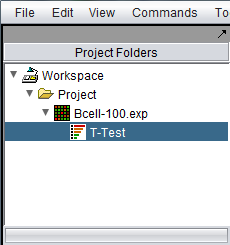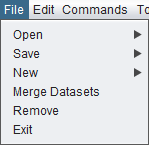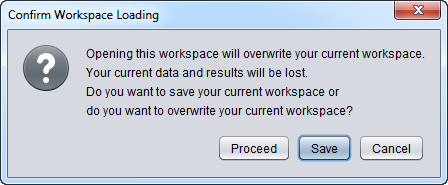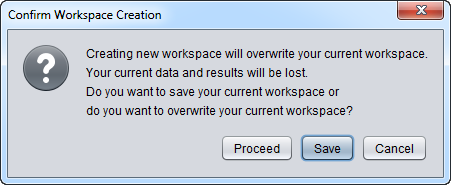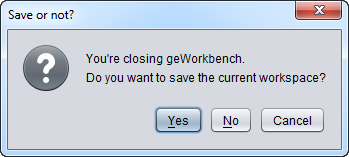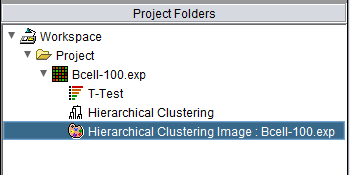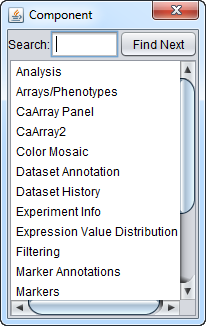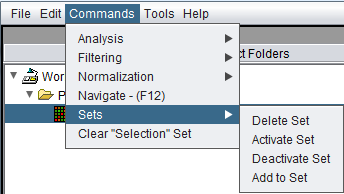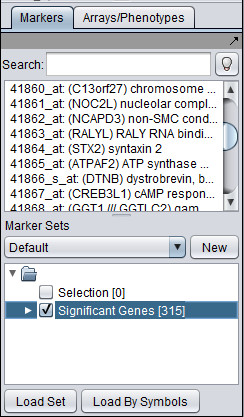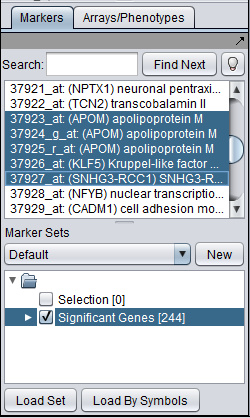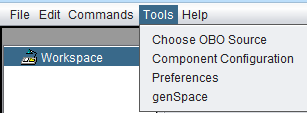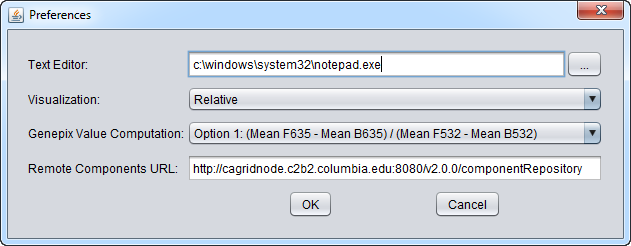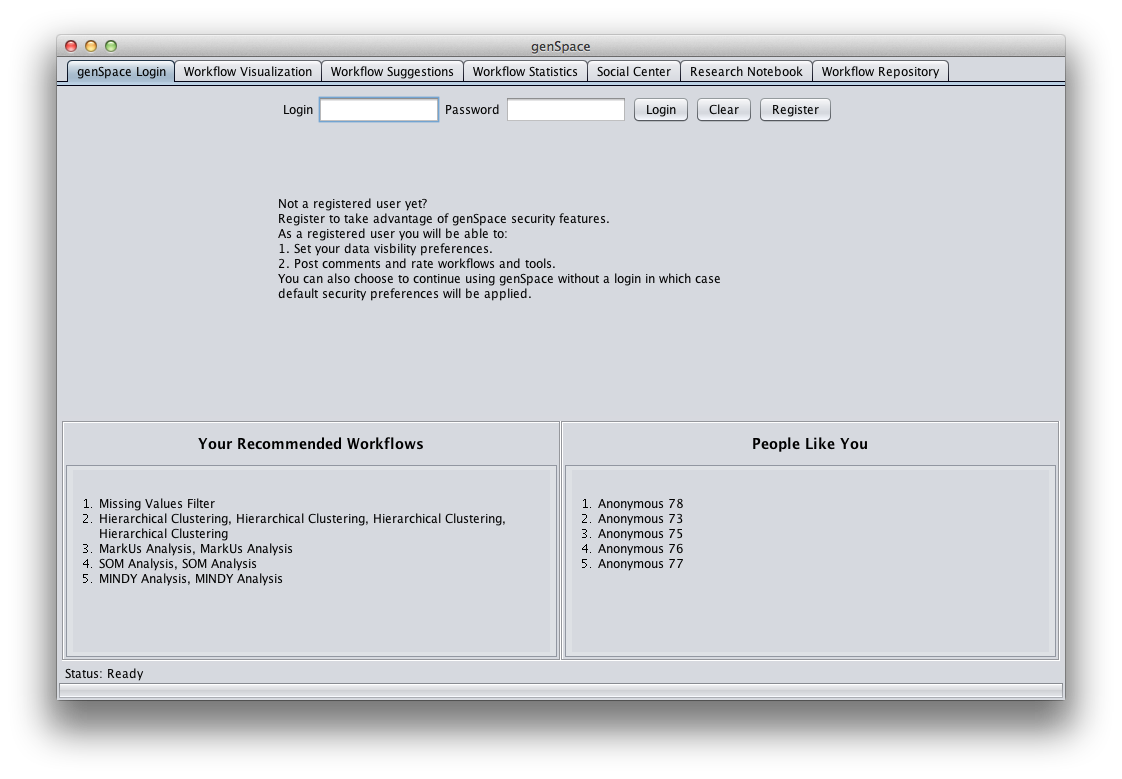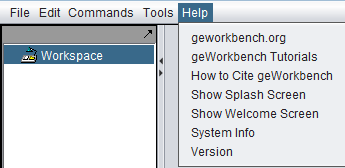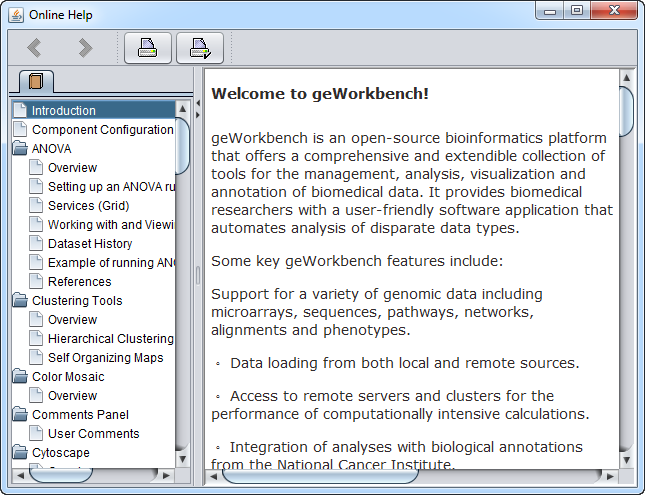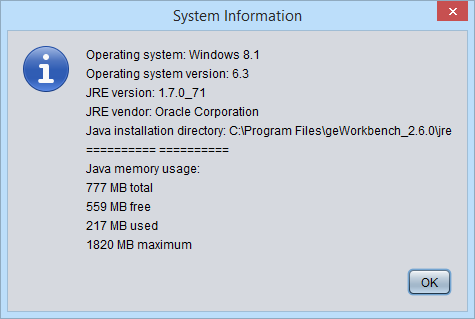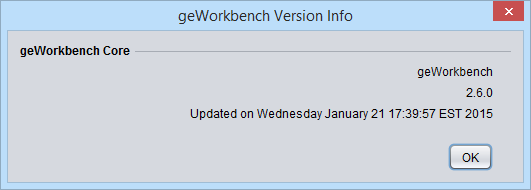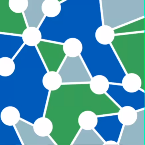Menu Bar
Contents
Introduction
The Menu Bar is located at the top of the geWorkbench graphical interface, and provides access to important actions, settings and information.
This section will briefly cover the individual menu items. Some items have their own more extensive documentation, and links to this will be provided.
The first two items in the menu, "File" and "Edit", apply to the Project Folders component, described in the next section.
Background on the Project Folders component
In brief, the Project Folders component is used for data organization and management. It contains four types of "nodes", arranged in a hierarchical fashion.
- Workspace - A workspace contains all the data for a geWorkbench session. Only one workspace can be present at a time. A workspace can be saved and reloaded. Workspaces are used to hold one or more projects.
- Project - A project is used to hold the data and the analysis results for a particular experiment. A workspace can contain more than one project, and one can easily switch between projects.
- Data nodes - These contain data either loaded from files on disk or retrieved from the network.
- Result nodes - After an analysis is done in geWorkbench, a result node is created as a child of the data node from which it was created.
The following diagram shows the Project Folders component with a single data node and its child t-test analysis result node.
Further details about the Project Folders component can be found in the Projects section.
File
The following choices are available under the File menu.
Open
- File - Open a specific data file from disk. A Project node must be selected in the Project Folders component. A standard file browser will appear, and the user can select from any of the file types that geWorkbench can directly load. The data file will be loaded into the selected project. If no project node yet exists, one must be created before a data file can be loaded.
- Note - The Open File action is also available by right-clicking on a Project node.
- Workspace - Open a previously saved geWorkbench workspace. A standard file browser will appear with which to locate the desired workspace file. As shown in the figure below, a dialog will appear warning the user that the current workspace will be overwritten. The user is offered the option to save the current workspace before proceeding. "Open Workspace" can be used regardless of what node is currently selected in the Project Folders component.
Save
- Workspace - Save the current geWorkbench workspace to a file on disk. All projects, data and result nodes will be saved.
New
- Workspace - Create a new workspace in the Project Folders component. Doing so will destroy the existing workspace, so the user will be prompted as to whether to save the current workspace. This is shown in the diagram below.
- Project - Within a workspace, create a new project. Any number of projects can be created in a workspace.
Export
- Export the microarray dataset currently selected in the Project Folders component in the "Affymetrix Matrix File Format" (.exp). This format preserves array sets that may have been defined.
Merge Datasets
If more than one data file originating from the same platform has been loaded into a project, the datasets can be merged into one for analysis.
Remove
This option will remove a project or a data node under the project from the Project Folders component. It will not remove a top-level workspace.
Exit
Close geWorkbench. The user will be prompted as to whether to save the workspace before closing.
Image Snapshot
Some graphical displays in the Visual Area (upper right-hand quadrant of geWorkbench) can be saved as snapshots into the Project Folders component. This can be used to "freeze" a particular view for later reference. These snapshots can also be saved to disk in several formats. Available formats are Bitmap, TIFF, PNG and JPEG.
The figure below shows an image snapshot node just below the dendrogram node from which it was created.
Edit
Rename
- Project - Rename the currently selected project. (Also works when a project child node is selected).
- File - Rename the currently selected data or result node.
View
Clear Selection
Clears the contents of the default "Selection" set in either the Markers or the Arrays component.
- Note - in version 2.2, this item moves to the "Commands" menu.
Commands
Clicking on "Navigate" in the menu, or hitting the "F12" key, will pop up a menu listing all windows open in geWorkbench. Double-clicking on an entry in the list will display that window (if it was previously hidden) and make it the active input window. Windows also can be searched for by name in the "Search" field at top.
Sets
The Sets menu item can be used to control sets that are selected in the Markers or in the Arrays/Phenotypes components. Shown below is a set "Significant markers" shown highlighted in the Markers component. The check-box next to its entry indicates that this set has also been "activated".
The Sets menu offers the following actions for acting on selected (highlighted) sets.
Delete
Delete the currently selected marker or array set(s). Multiple sets can be selected an acted on at one time.
Activate
Activate the currently selected marker or array set(s). Multiple sets can be selected an acted on at one time.
Deactivate
Deactivate the currently selected marker or array set(s). Multiple sets can be selected an acted on at one time.
Add to Set
Individual markers or arrays selected in the upper list will be added to an existing or new marker or array set.
In the figure below, if "Add to Set" is selected, a popup will appear allowing the user to add the selected markers to an existing set, or to create a new set. By default, this popup will show an existing set if one is highlighted.
The same actions apply to array sets also.
Tools
Component Configuration
geWorkbench has a large selection of components applicable to many different areas of biological data analysis. A particular investigator may wish to load only the components needed for his or her own analysis.
The Component Configuration Manager allows individual geWorkbench components to be loaded or unloaded. Full details on its use are available in the Component Configuration Manager tutorial chapter.
Preferences
Text Editor
The user can change the default text editor used to view data files. For example, when you right-click on a data node in the Project Folders component, "View in Editor" is one of the options offered.
Visualization
Heat maps, e.g. in the Color Mosaic component, can be displayed using either a relative or an absolute color scheme.
- Absolute
- Red represents positive expression values, and green represents negative expression values. Black represents a value of zero. The shade represents the expression magnitude as follows:
- Formal spec: Let M = max{|min|, |max|} over all expression measurements, across all arrays. If expression value x > 0, assign it the red spectrum x / M * 256. If expression value x is negative, assign it to the green spectrum -x / M * 256.
- Relative (default)
- Relative is similar to the setting for Absolute, but each marker is mean-variance normalized first. A Red-Blue color scheme is used, with red representing the highest values and blue the lowest. White represents the marker average.
- Note - Relative will give odd-looking results if only a small number of arrays are loaded.
- Note - Changing the Microarray Viewer relative/absolute preference will not take effect until the next time a data set is loaded.
GenePix Value Computation
Four methods for calculating a composite expression measurement for each marker in a GenePix file are offered. They combine the foreground and background and mean or median measurements from each channel in different ways.
- ( F635 Mean - B635 Mean) / (F532 Mean - B532 Mean).
- ( F635 Median - B635 Median) / (F532 Median - B532 Median).
- ( F532 Mean - B532 Mean) / (F635 Mean - B635 Mean).
- ( F532 Median - B532 Median) / (F635 Median - B635 Median).
See the entry GenePix Format in the GenePix tutorial chapter for further details of processing GenePix data on input.
Remote Components URL
geWorkbench can download certain components from a network repository. This specifies the location of the network component repository.
genSpace
genSpace is covered in its own chapter in these tutorials.
Help
Help Topics
geWorkbench has self-contained help chapters for a number of its components. These chapters are installed directly on the machine with geWorkbench and do not depend on network connectivity. They are implemented using the Java Help component. In most cases, the content is similar or identical to the material available in the corresponding geWorkbench tutorial sections.
Chapters are navigated by clicking on the desired chapter or section in the list on the left side of the component, the material is displayed in the built-in browser on the right-hand side of the component.
Links to external sites
geWorkbench.org - This is the URL of the geWorkbench project home page. It contains full information about geWorkbench.
Knowledge Center - The National Cancer Institute's Molecular Analysis Tools Knowledge Center provides user support for geWorkbench.
About
Displays the geWorkbench startup splash screen with developer credits.
Welcome Screen
The Wecome Screen is displayed the first time a new version of geWorkbench is run on a computer. It displays introductory information about how to learn about using geWorkbench. It may also provide version-specific notices.
- The Welcome Screen is dismissed by pushing its "Hide" button.
- The Welcome Screen can be recalled at any time by selecting "Welcome Screen" under the main menu bar Help entry.
- The Welcome screen remembers whether is was being displayed or not last time geWorkbench was closed, and will be in the same state when geWorkbench is next run.
System Info
Displays information about the operating system, the Java version and Java memory usage.
Version Info
Displays the version number of the currently running copy of geWorkbench. It also displays the date on which that version was created.
